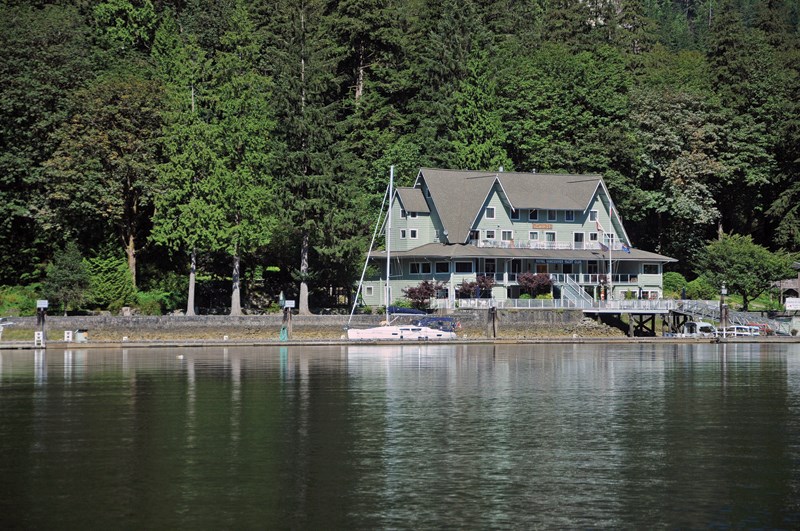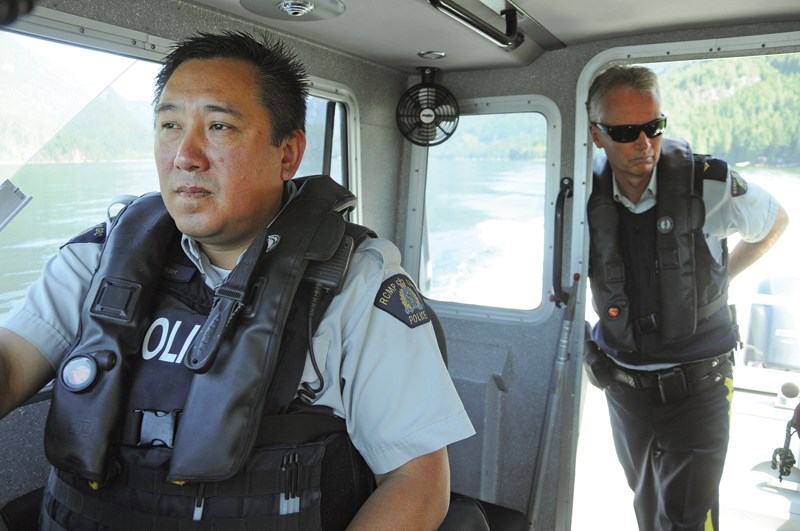RCMP Const. Joey Starr steers the rigid hull inflatable aluminum boat as it bounces over the choppy water of Burrard Inlet on a recent warm mid-August morning.
He makes his way from the Mosquito Creek Marina where the RCMP vessel is moored, passes under the Second Narrows bridge and charts a course for Cates Park.
The huge smile washing over Starr’s face means he’s home.
“I enjoy the water, being out here,” says Starr, shouting over the roar of the motor. “You get a lot of the smells, being on the water. It sort of brings me back to when I was a commercial fisherman.”
Starr grew up on the ocean. His affinity for the outdoors started when Starr was teenager in the Gitxsan First Nation village of Kispiox, located 13 kilometres north of Hazelton, B.C. He would always go salmon and halibut fishing with his dad and uncle in the waters off of Prince Rupert. Naturally, Starr gravitated towards marine policing after graduating from the RCMP’s training academy. “Just like any position within the RCMP, if you have a passion for something you’ll educate yourself more in that field. So for me, I love the outdoors,” says Starr, an Integrated First Nations Unit squad member.
Patrolling the placid waters of Indian Arm has a calming effect on Starr, who can sometimes experience a more serious side of policing while making the rounds on land in his cruiser.
Starr first arrived on the Arm in 2009, ready to educate boaters and fishermen, rather than enforce the law right away. He is mainly looking for Canada Shipping Act and federal fisheries offences in an area considered a hotbed for crabbing.
While officers might deal with a couple of impaired boating cases a year and some other infractions on Indian Arm, 95 per cent of all charges, says Starr, are fisheries related. About three years ago Starr started laying down the law after catching many people with undersize crab. “A lot of people plead ignorance, or (say) ‘I was going to measure it later,’” he says.
The rule is once you pull your trap up you have to measure the crab right away, explains Starr. If the crustacean is undersize it immediately has to go back in the water.
There is no leeway, even for first offenders, “it’s charge, charge, charge,” says Starr who has to be “very sticky” with the regulations around crabbing. And it can be a costly lesson. One illegal crab can net an offender three different charges. Possessing female crabs alone carries a potential fine of $500 per crab.
During one crabbing bust, Starr checked three guys in a boat who were caught with 49 crabs, only three of which were legal and the majority of them females. The men also had 55 oysters in their possession, in an area that’s closed off for oyster harvesting.
“So they basically came out super early in the morning and were just taking everything – and that’s when we come along,” explains Starr.
Preserving crab stocks in Indian Arm is part of the reason Starr has a passion for this part of policing.
“Because the way I look at it, if we don’t protect it, we’re going to lose it,” he says. “Somebody’s got to come out here and do this kind of stuff because the offences you are seeing really have a huge impact on the survival of the species. When you’ve got guys taking a ton of females (crabs) out – that’s going to reduce the numbers.”
A navigational screen glows in front of Starr at the steering wheel, not that he needs to rely on a GPS today. Starr knows North Van’s famous fjord like the back of his hand and points out various landmarks on our way up the Arm.
The waterway is split down the middle, he explains. The west side of Indian Arm is located on District of North Vancouver and Tsleil-Waututh Nation lands, while the Village of Belcarra occupies the east side. We cruise by the old Buntzen power station that stands like a fortress on the eastern shoreline. Starr says the building was designed by Francis Rattenbury, the British architect behind Victoria’s famous Parliament buildings and Empress Hotel.
Midway up the Arm, Starr spots an orange marking on a craggy cliff face and brings the boat close to shore.
“You can see the wings spread open, the eye,” says Starr, craning his neck from behind the windshield to look up at the rock face.
Starr is sure it’s an aboriginal thunderbird symbol, but he doesn’t know how or when it was painted here. The thunderbird is an artistic symbol of the Squamish Nation and is depicted looking down from above to “watch over the safety of all people.”

Parallels can be made to Starr’s presence in Indian Arm, as his job is to ensure all who visit or reside in the remote area stay safe.
A jovial guy, Starr gives a wave to passing boaters. He knows all the regulars. But there’s no guessing when Starr might show up for a shift. “I want to be there when people least expect the police to be out – that’s when you are going to find me,” says Starr, who can patrol the Arm at odd hours of the night and in any weather including the occasional snowstorm.
Starr looks over to his left and recognizes the maintenance worker from Camp Jubilee cruising alongside him. He shouts across the water to Starr and jokingly asks if the officer is going to chase him in with lights and sirens. “I should,” Starr shouts back with a hearty chuckle.
Camp Jubilee is a special place for Starr who every summer hosts First Nations youth for a week as part of a program he conceived called Project ESCAPe. Starr takes advantage of Indian Arm’s serenity and natural splendour to reconnect aboriginal youth with the great outdoors.
He also responds to calls from off-the-grid residences that dot the Arm. Starr, along with a dozen other officers from his detachment, share Indian Arm policing duties with Coquitlam RCMP members. We reach the north end of the Arm where the famous Wigwam Inn lies. Starr is fascinated by the notorious piece of North Van history once visited by John D. Rockefeller and now owned by the Royal Vancouver Yacht Club. “Inside is pretty neat, they have a lot of the old photos,” says Starr. They have an old ledger of when people were staying there. It used to be a brothel at one time.”
At the end of the line where the sea meets the land, is the start of Starr’s other beat. He patrols a rough 35-kilometre service road that stretches from the north end of Indian Arm to Squamish. It’s ATV country up here and Starr is making sure people have their machines registered and third-party liability insurance. He is also looking for firearm offences in the remote area. “A lot of these people come around and they think, ‘Oh the police will never come out here,’” says Starr.
Heading back down the Arm on the Belcarra side, Starr stops alongside a group of young canoers from one of the summer camps in the area and checks to make sure they have their safety gear.
“So, is everyone actually paddling or do you have some lilly dippers in there?” he asks. They laugh. “Alright guys, well you guys have fun and be safe,” says Starr, who sends the canoers on their way.
At the end of the day, that’s what Starr likes to see: everyone enjoying Indian Arm’s splendour as much as he does.



